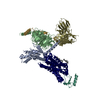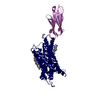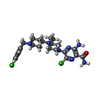+ Open data
Open data
- Basic information
Basic information
| Entry | Database: PDB / ID: 8hnn | ||||||
|---|---|---|---|---|---|---|---|
| Title | Structure of CXCR3 complexed with antagonist SCH546738 | ||||||
 Components Components |
| ||||||
 Keywords Keywords | SIGNALING PROTEIN / G protein coupled receptor / chemokine receptor / CXCR3 / SCH546738 / complex | ||||||
| Function / homology |  Function and homology information Function and homology informationresponse to acrylamide / regulation of saliva secretion / regulation of leukocyte migration / sensory perception of temperature stimulus / positive regulation of eating behavior / C-X-C chemokine binding / adenylate cyclase-inhibiting opioid receptor signaling pathway / chemokine binding / G protein-coupled opioid receptor activity / negative regulation of luteinizing hormone secretion ...response to acrylamide / regulation of saliva secretion / regulation of leukocyte migration / sensory perception of temperature stimulus / positive regulation of eating behavior / C-X-C chemokine binding / adenylate cyclase-inhibiting opioid receptor signaling pathway / chemokine binding / G protein-coupled opioid receptor activity / negative regulation of luteinizing hormone secretion / C-X-C chemokine receptor activity / dynorphin receptor activity / chemokine receptor activity / G protein-coupled opioid receptor signaling pathway / positive regulation of dopamine secretion / C-C chemokine receptor activity / sensory perception / C-C chemokine binding / positive regulation of potassium ion transmembrane transport / positive regulation of chemotaxis / negative regulation of execution phase of apoptosis / maternal behavior / conditioned place preference / receptor serine/threonine kinase binding / neuropeptide binding / Chemokine receptors bind chemokines / positive regulation of p38MAPK cascade / eating behavior / positive regulation of execution phase of apoptosis / negative regulation of endothelial cell proliferation / behavioral response to cocaine / neuropeptide signaling pathway / estrous cycle / regulation of cell adhesion / MECP2 regulates neuronal receptors and channels / axon terminus / T-tubule / sensory perception of pain / adenylate cyclase-inhibiting G protein-coupled receptor signaling pathway / negative regulation of angiogenesis / cell chemotaxis / Peptide ligand-binding receptors / positive regulation of release of sequestered calcium ion into cytosol / sarcoplasmic reticulum / locomotory behavior / response to nicotine / cellular response to glucose stimulus / adenylate cyclase-activating G protein-coupled receptor signaling pathway / calcium-mediated signaling / electron transport chain / response to insulin / synaptic vesicle membrane / response to estrogen / positive regulation of angiogenesis / chemotaxis / signaling receptor activity / presynaptic membrane / phospholipase C-activating G protein-coupled receptor signaling pathway / positive regulation of cytosolic calcium ion concentration / G alpha (i) signalling events / cellular response to lipopolysaccharide / angiogenesis / chemical synaptic transmission / defense response to virus / perikaryon / postsynaptic membrane / response to ethanol / periplasmic space / electron transfer activity / cell surface receptor signaling pathway / cell adhesion / inflammatory response / neuron projection / immune response / iron ion binding / G protein-coupled receptor signaling pathway / external side of plasma membrane / dendrite / positive regulation of cell population proliferation / heme binding / apoptotic process / cell surface / positive regulation of transcription by RNA polymerase II / mitochondrion / nucleoplasm / membrane / plasma membrane / cytosol / cytoplasm Similarity search - Function | ||||||
| Biological species |    Homo sapiens (human) Homo sapiens (human) | ||||||
| Method | ELECTRON MICROSCOPY / single particle reconstruction / cryo EM / Resolution: 3.6 Å | ||||||
 Authors Authors | Jiao, H.Z. / Hu, H.L. | ||||||
| Funding support |  China, 1items China, 1items
| ||||||
 Citation Citation |  Journal: Nat Struct Mol Biol / Year: 2024 Journal: Nat Struct Mol Biol / Year: 2024Title: Structural insights into the activation and inhibition of CXC chemokine receptor 3. Authors: Haizhan Jiao / Bin Pang / Aijun Liu / Qiang Chen / Qi Pan / Xiankun Wang / Yunong Xu / Ying-Chih Chiang / Ruobing Ren / Hongli Hu /  Abstract: The chemotaxis of CD4 type 1 helper cells and CD8 cytotoxic lymphocytes, guided by interferon-inducible CXC chemokine 9-11 (CXCL9-11) and CXC chemokine receptor 3 (CXCR3), plays a critical role in ...The chemotaxis of CD4 type 1 helper cells and CD8 cytotoxic lymphocytes, guided by interferon-inducible CXC chemokine 9-11 (CXCL9-11) and CXC chemokine receptor 3 (CXCR3), plays a critical role in type 1 immunity. Here we determined the structures of human CXCR3-DNG complexes activated by chemokine CXCL11, peptidomimetic agonist PS372424 and biaryl-type agonist VUF11222, and the structure of inactive CXCR3 bound to noncompetitive antagonist SCH546738. Structural analysis revealed that PS372424 shares a similar orthosteric binding pocket to the N terminus of CXCL11, while VUF11222 buries deeper and activates the receptor in a distinct manner. We showed an allosteric binding site between TM5 and TM6, accommodating SCH546738 in the inactive CXCR3. SCH546738 may restrain the receptor at an inactive state by preventing the repacking of TM5 and TM6. By revealing the binding patterns and the pharmacological properties of the four modulators, we present the activation mechanisms of CXCR3 and provide insights for future drug development. | ||||||
| History |
|
- Structure visualization
Structure visualization
| Structure viewer | Molecule:  Molmil Molmil Jmol/JSmol Jmol/JSmol |
|---|
- Downloads & links
Downloads & links
- Download
Download
| PDBx/mmCIF format |  8hnn.cif.gz 8hnn.cif.gz | 89.9 KB | Display |  PDBx/mmCIF format PDBx/mmCIF format |
|---|---|---|---|---|
| PDB format |  pdb8hnn.ent.gz pdb8hnn.ent.gz | 61.1 KB | Display |  PDB format PDB format |
| PDBx/mmJSON format |  8hnn.json.gz 8hnn.json.gz | Tree view |  PDBx/mmJSON format PDBx/mmJSON format | |
| Others |  Other downloads Other downloads |
-Validation report
| Summary document |  8hnn_validation.pdf.gz 8hnn_validation.pdf.gz | 496.2 KB | Display |  wwPDB validaton report wwPDB validaton report |
|---|---|---|---|---|
| Full document |  8hnn_full_validation.pdf.gz 8hnn_full_validation.pdf.gz | 499.4 KB | Display | |
| Data in XML |  8hnn_validation.xml.gz 8hnn_validation.xml.gz | 9.5 KB | Display | |
| Data in CIF |  8hnn_validation.cif.gz 8hnn_validation.cif.gz | 14 KB | Display | |
| Arichive directory |  https://data.pdbj.org/pub/pdb/validation_reports/hn/8hnn https://data.pdbj.org/pub/pdb/validation_reports/hn/8hnn ftp://data.pdbj.org/pub/pdb/validation_reports/hn/8hnn ftp://data.pdbj.org/pub/pdb/validation_reports/hn/8hnn | HTTPS FTP |
-Related structure data
| Related structure data |  34917MC  8hnkC  8hnlC  8hnmC M: map data used to model this data C: citing same article ( |
|---|---|
| Similar structure data | Similarity search - Function & homology  F&H Search F&H Search |
- Links
Links
- Assembly
Assembly
| Deposited unit | 
|
|---|---|
| 1 |
|
- Components
Components
| #1: Antibody | Mass: 18665.906 Da / Num. of mol.: 1 Source method: isolated from a genetically manipulated source Source: (gene. exp.)   |
|---|---|
| #2: Protein | Mass: 56327.051 Da / Num. of mol.: 1 Source method: isolated from a genetically manipulated source Source: (gene. exp.)   Homo sapiens (human) Homo sapiens (human)Gene: cybC, CXCR3, GPR9, OPRK1, OPRK / Production host:  References: UniProt: P0ABE7, UniProt: P49682, UniProt: P41145 |
| #3: Chemical | ChemComp-43I / |
| #4: Chemical | ChemComp-CLR / |
| Has ligand of interest | Y |
| Has protein modification | Y |
-Experimental details
-Experiment
| Experiment | Method: ELECTRON MICROSCOPY |
|---|---|
| EM experiment | Aggregation state: PARTICLE / 3D reconstruction method: single particle reconstruction |
- Sample preparation
Sample preparation
| Component | Name: CXCR3-KOR-SCH546738-Nb6 / Type: COMPLEX / Entity ID: #1-#2 / Source: MULTIPLE SOURCES |
|---|---|
| Source (natural) | Organism:  Homo sapiens (human) Homo sapiens (human) |
| Source (recombinant) | Organism:  |
| Buffer solution | pH: 7.5 |
| Specimen | Conc.: 5 mg/ml / Embedding applied: NO / Shadowing applied: NO / Staining applied: NO / Vitrification applied: YES |
| Vitrification | Cryogen name: ETHANE / Humidity: 100 % |
- Electron microscopy imaging
Electron microscopy imaging
| Experimental equipment |  Model: Titan Krios / Image courtesy: FEI Company |
|---|---|
| Microscopy | Model: FEI TITAN KRIOS |
| Electron gun | Electron source:  FIELD EMISSION GUN / Accelerating voltage: 300 kV / Illumination mode: FLOOD BEAM FIELD EMISSION GUN / Accelerating voltage: 300 kV / Illumination mode: FLOOD BEAM |
| Electron lens | Mode: BRIGHT FIELD / Nominal magnification: 105000 X / Nominal defocus max: 2000 nm / Nominal defocus min: 1500 nm / Cs: 2.7 mm / C2 aperture diameter: 100 µm |
| Image recording | Electron dose: 53.43 e/Å2 / Film or detector model: GATAN K3 BIOQUANTUM (6k x 4k) |
| EM imaging optics | Energyfilter name: GIF Bioquantum / Energyfilter slit width: 20 eV |
- Processing
Processing
| EM software | Name: Gctf / Category: CTF correction | ||||||||||||||||||||||||
|---|---|---|---|---|---|---|---|---|---|---|---|---|---|---|---|---|---|---|---|---|---|---|---|---|---|
| CTF correction | Type: PHASE FLIPPING AND AMPLITUDE CORRECTION | ||||||||||||||||||||||||
| 3D reconstruction | Resolution: 3.6 Å / Resolution method: FSC 0.143 CUT-OFF / Num. of particles: 509297 / Symmetry type: POINT | ||||||||||||||||||||||||
| Refine LS restraints |
|
 Movie
Movie Controller
Controller






 PDBj
PDBj

























